The Fellowship of Samoa Specialists, a group of avid collectors of Samoan stamps and postal history, was founded in 1979 by Jack R. Hughes of the United States. Today this group has members in a dozen countries who share their knowledge through The Samoa Express, a quarterly journal edited by Trevor Shimell of the United Kingdom. The other officers are Jan Berg of Sweden (president), Wolfgang Hermann (vice-president) from Germany and Steve Zirinsky (secretary) of the United States. This web site is hosted by Jan Berg of Sweden.
For a complimentary sample copy of the Fellowship’s journal, and a membership application, please e-mail or write to Trevor Shimell, 18 Aspen Drive, Newton Abbot, Devon TQ12 4TN, UNITED KINGDOM.
You can also download an application here.
Samoa’s Postal History
In 1870, G. L. Griffiths, an enterprising pioneer printer and publisher of The Fiji Times, saw the need for a postal service in the local islands and to overseas countries. At this time, Fiji was a most important trading centre of the South Seas. Griffiths opened his ’non-government’ post office, ”The Fiji Times Express”, on October 15, 1870. The project was financially quite successful.
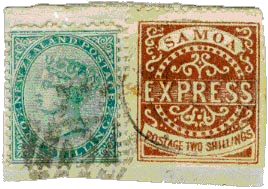
The success of Griffiths’s enterprise appears to have influenced him to spread his wings. He selected Samoa as his next conquest, but failed to appreciate the differences in the situations of the two island groups. Fiji had about 80 inhabited islands where there were about 2,000 European traders and missionaries. Samoa on the other hand in 1877 had only 130 Europeans, the majority of whom lived in Apia. As Griffiths was the publisher of the newspaper Samoa Times, the formation of his second ”non-government” post office was also a means of expediting delivery of his own publication.
The Samoa Times Express stamps are legendary. During the period from 1877 to 1881 there were seven different values issued — 1d, 3d, 6d, 9d, 1s, 2s, and 5s. These stamps have been reprinted and forged. The Samoan Express postal venture closed during September 1881.
Another postal chapter in the group’s history began in 1885 when Apia photographer John Davis claimed he had been appointed Postmaster by the counsuls of Great Britain, the United States, and Germany. However, he didn’t officially make this announcement until 1886, probably only when news was released of the opening of a German postal agency on September 21, 1886. At that time, Davis was committed to some considerable expense as he had ordered a substantial initial quantity of stamps from the New Zealand Government Printer in Wellington. The stamps in Davis’s regime comprised three designs — King Malietoa, the Palm Trees, and the Flags. His postal agency operated until the opening of an official post office by the German Imperial Government on March 1, 1900. This followed a treaty agreement when Samoa was partitioned between Germany and the United States.
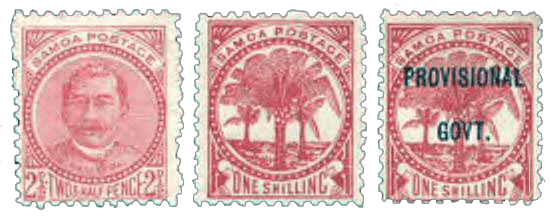
The first stamps for the German postal agency were regular German stamps, distinguisable only by the APIA cancel. The first issue specifically for German Samoa were six current German issues of 1900 diagonally overprinted Samoa. They had only a short life until the Imperial Printing Office in Berlin prepared the regular stamps of common design then used throughout the colonial empire. These stamps featured the yacht Hohenzollern, belonging to Kaiser Wilhelm II. The German series remained on sale until the landing of the New Zealand Expeditionary Forces on August 29, 1914.
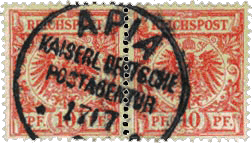
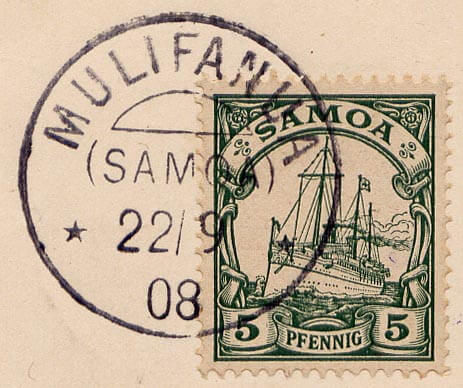
The Kiwis immediately banned the German stamps — on the first evening of the occupation, a notice was posted declaring the German Mark and Pfennig values obsolete. Stocks of German stamps were seized, and the New Zealand occupying forces began overprinting the stamps G.R.I. (Georgius Rex Imperator), and surcharging them in British currency. A number of varieties were produced, and this is a rich collecting area.
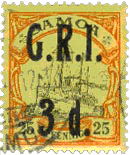
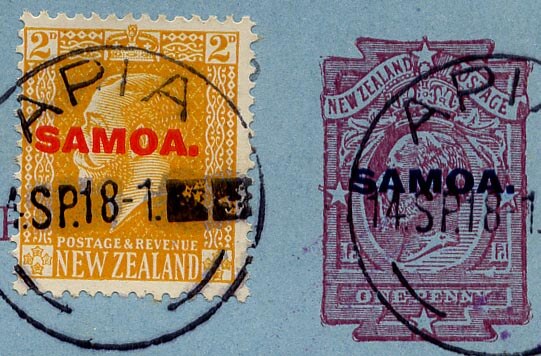
The use of the surcharged German stamps came to a halt in September/October 1914 when current New Zealand stamps and postal stationery were overprinted SAMOA.
On December 23, 1921, Samoa’s first pictorial series under New Zealand control appeared. This issue, called the ”Hut” issue, showed the Samoan flag and a fale (hut).
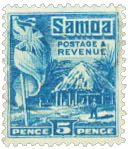
Western Samoa became a League of Nations and later United Nations Trust Territory, administered by New Zealand, and issued stamps inscribed ”Samoa” or ”Western Samoa”. On January 1, 1962, Samoa i Sisifo achieved independence, and has since issued many attractive stamps, with printing contracts shared around the world.
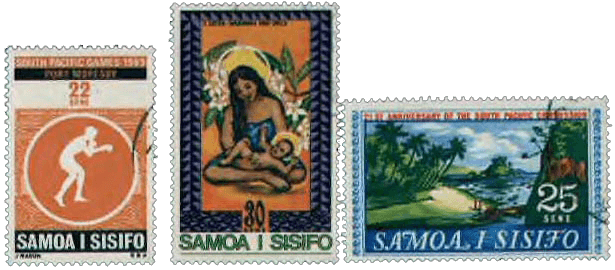
Links
These links are provided solely as a service to the readers. The Fellowship of Samoa Specialists cannot attest to the correctness of the information provided at the links.
Philatelic links:
Selected Bibliography
Provided by Nigel Sawyer and Kevin Doyle
Fellowship of Samoa Specialists (Bulletin), edited by Jack R. Hughes (1979-1980, 1984-1985), Brian Purcell (1980-1982), Guy J. L. Hamilton (1986-1996), Donald A. T. Mee (1997-present). This is the journal of the Fellowship. In 1997, the title was changed to The Samoa Express, Journal of the Fellowship of Samoa Specialists.
Postal History of the Samoan Islands (Monograph Series No. 6, 1987) and Postal History of the Samoan Islands Part II (Monograph Series No. 10, 1989), ed. Richard Burge, Royal Philatelic Society of New Zealand. Excellent starting point although no information is given on rates and on the mail services of the WWI period.
The Postage Stamps of New Zealand, Volume 5, ed. R. J. G. Collins, Royal Philatelic Society of New Zealand (1965). Chapters XXXIII, XXXIV (by Jack R. Hughes), and XXXV-XLIX give the basic information as known in 1965.
Cook Islands and Samoa, The ’Floyd W. Fitzpatrick’ Collections, Sale No. 5677, Stanley Gibbons Auctions, (13-14 December 1989). Invaluable reference source for much Samoan material.
Robert M. Gibbs, G. R. I., Christie’s-Robson Lowe, London (1988). Detailed handbook on the ”G.R.I.” overprints.
”Correspondence relating to the occupation of German Samoa by an expeditionary force from New Zealand”, H.M.S.O., London (1915). Documents much of the official British correspondence relating to the occupation.
Jürgen Killian, ”The World War One Occupation of Samoa — History and Philately”, VORLÜFER No. 33 (1977-8). Documents much of the official German correspondence relating to the occupation.
Emil Klehn, ”The Passing of Samoa to British Rule”, The Australian Philatelist Vol. XXI, No.3 (3 November 1914). Details of the invasion and ”G.R.I.” stamps.
Rohbert T. Murphy, A Postal History / Cancellation Study of the U. S. Pacific Islands (including the Trust Territories), American Philateic Society, State College (1983). Part III discussed American Samoa.
Robert P. Odenweller, The Stamps and Postal History of Nineteenth Century Samoa, Royal Philatelic Society London and the Royal Philatelic Society of New Zealand (2004). The definitive work on 19th century Samoa.
Robin Startup, ”Occupation of Samoa 1914”, New Zealand Stamp Collector, Vol. 57, No. 1 (March 1977). Copy of Lt. Dingle’s report to the Chief Postmaster, Auckland dated 28th October 1914.